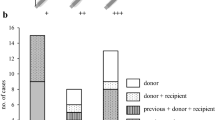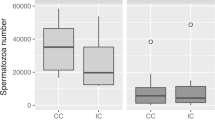Summary
Copulation in Ischnura graellsii may be divided into three stages, according to the movements and position of the male's abdomen. We measured sperm volumes in males and females interrupted at different phases of copulation in laboratory-reared and field specimens. The results showed that males remove sperm from the female during stage I, and do not transfer sperm until stage Il of the copulation. In the field females interrupted during stage I of copulation had less sperm than postcopula females, and the volume of sperm in laboratory females mated once or twice was similar. These results suggest that males can remove most of the sperm during stage I of copulation. Preparations of in-copula specimens showed the horns of the penis (used to remove sperm) inside the bursa copulatoox and the spermatheca. Therefore males can remove sperm from both organs, in contrast to the other Ischnura species so far studied, where males can empty only the bursa. The length of these horns is positively correlated with male body length, and there are significant differences in length between the left and right horns of individual males. This suggests great variability in the male's ability to remove sperm. On the other hand, ejaculate volume is positively related to male and female size, and negatively to male age. Males are likely to be able to detect the presence of sperm in females: if the effect of population density and time of start of copulation are taken into account, copulations are longer with mated than with virgin females. Using genetic markers, sperm precedence was studied by rearing the female offspring of 6 females mated with two males of different genotype. In 5 out of 6 crosses, the second male fertilized all the eggs laid by the female in her first clutch. On average, the following clutches were progressively more fertilized by the first male, but there were striking differences between crosses. These differences are probably due to the variability in the amount of sperm transferred and/or removed.
Similar content being viewed by others
References
Banks MJ, Thompson DJ (1985) Lifetime mating success in the damselfly Coenagrion puella. Anim Behav 33:1175–1183
Cordero A (1987) Estructura de población en Ischnura graellsii Rambur, 1842 (Zygop Coenagrionidae). Boletín Asoc Esp Entomol 11:269–286
Cordero A (1989) Reproductive behaviour of Ischnura graellsii (Rambur) (Zygoptera: Coenagrionidae). Odonatologica 18:237–244
Cordero A (1990a) The adaptive significance of the prolonged copulations of the damselfly, Ischnura graellsii (Odonata: Coenagrionidae). Anim Behav 40:43–48
Cordero A (1990b) The inheritance of female polymorphism in the samselfly Ischnura graellsii (Rambur) (Odonata: Coenagrionidae). Heredity 64:341–346
Diesel R (1988) Discrete storage of multiple mating sperm in the Spider Crab Inachus phalangium. Naturwissenschaften 75:148–149
Fincke OM (1982) Lifetime mating success in a natural population of the damselfly, Enallagma hageni (Walsh) (Odonata: Coenagrionidae). Behav Ecol Sociobiol 10:293–302
Fincke OM (1984) Sperm competition in the damselfly Enallagma hageni Walsh (Odonata: Coenagrionidae): benefits of multiple mating to males and females. Behav Ecol Sociobiol 14:235–240
Fincke OM (1986) Underwater oviposition favors male vigilance and female multiple mating in a damselfly (Odonata: Coenagrionidae). Behav Ecol Sociobiol 18:405–412
Fincke OM (1987) Female monogamy in Ischnura verticalis Say (Zygoptera, Coenagrionidae). Odonatologica 16:129–143
Gwynne DT (1984) Male mating effort, confidence of paternity, and insect sperm competition. In: Smith RL (ed) Sperm competition and the evolution of animal mating systems. Academic Press, Orlando, pp 117–149
Hafernik JE, Garrison RW (1986) Mating success and survival rate in a population of damselflies: results at variance with theory? Am Nat 128:353–365
Lewis SM, Austad SN (1990) Sources of intraspecific variation in sperm precedence in red flour beetles. Am Nat 135:351–359
McVey ME, Smittle BJ (1984) Sperm precedence in the dragonfly Erythemis simplicicollis. J Insect Physiol 30:619–628
Michiels NK, Dhondt AA (1988) Direct and indirect estimates of sperm precedence and displacement in the dragonfly Sympetrum danae (Odonata: Libellulidae). Behav Ecol Sociobiol 23:257–263
Miller PL (1987a) An examination of the prolonged copulations of Ischnura elegans (Vander Linden) (Zygoptera: Coenagrionidae). Odonatologica 16:37–56
Miller PL (1987b) Sperm competition in Ischnura elegans (Vander Linden) (Zygoptera: Coenagrionidae). Odonatologica 16:201–207
Møller AP (1989) Ejaculate quality, testes size and sperm production in mammals. Funct Ecol 3:91–96
Møller AP, Birkhead TR (1989) Copulation behaviour in mammals: evidence that sperm competition is widespread. Biol J Linn Soc 38:119–131
Parker GA (1970) Sperm competition and its evolutionary consequences in the insects. Biol Rev 45:525–567
Siva-Jothy MT (1984) Sperm competition in the family Libellulidae (Anisoptera) with special reference to Crocothemis erythraea (Brullé) and Orthetrum cancellatum (L.). Adv Odonatol 2:195–207
Siva-Jothy MT (1987) Variation in copulation duration and the resultant degree of sperm removal in Orthetrum cancellatum (L.). (Libellulidae: Odonata). Behav Ecol Sociobiol 20:147–151
Siva-Jothy MT, Tsubaki Y (1989) Variation in copulation duration in Mnais pruinosa pruinosa Selys (Odonata: Calopterygidae). 1. Alternative mate-securing tactics and sperm precedence. Behav Ecol Sociobiol 24:39–45
Smith RL (1984) Human sperm competition. In: Smith RL (ed) Sperm competition and the evolution of animal mating systems. Academic Press, Orlando, pp 601–659
Snedden WA (1990) Determinants of male mating success in the temperate crayfish Oronectes rusticus: chela size and sperm competition. Behaviour 115:100–113
Steel RGD, Torrie JH (1985) Bioestadística: principios y procedimientos. McGraw-Hill, Bogotá
Suter RB (1990) Courtship and the assessment of virginity by male bowl and doily spiders. Anim Behav 39:307–313
Utzeri C, Sorce G (1988) La guardia pre- e post-copula negli zigotteri: due casi specializzati. Atti XV Congr naz ital Ent L'Aquila 1988:731–737
Waage JK (1979) Dual function of the damselfly penis: sperm removal and transfer. Science 203:916–918
Waage JK (1980) Adult sex ratios and female reproductive potential in Calopteryx (Zygoptera: Calopterygidac). Odonatologica 9:217–230
Waage JK (1982) Sperm displacement by male Lestes vigilax Hagen (Zygoptera: Lestidae). Odonatologica 11:201–209
Waage JK (1984) Sperm competition and the evolution of odonate mating systems. In: Smith RL (ed) Sperm competition and the evolution of animal mating systems. Academic Press, Orlando, pp 251–290
Waage JK (1986a) Evidence for widespread sperm displacement ability among Zygoptera (Odonata) and the means for predicting its presence. Biol J Linn Soc 28:285–300
Waage JK (1986b) Sperm displacement by two libellulid dragonflies with disparate copulation durations (Anisoptera). Odonatologica 15:429–444
Waage JK (1988) Reproductive behavior of the damselfly Calopteryx dimidiata Burmeister (Zygoptera: Calopterygidae). Odonatologica 17:365–378
Watanabe M, Adachi Y (1987) Fecundity and oviposition pattern of the damselfly Copera annulata (Selys) (Zygoptera: Platycnemididae). Odonatologica 16:85–92
Wolf LL, Waltz EC, Wakeley K, Klockowski D (1989) Copulation duration and sperm competition in white-faced dragonflies (Leucorrhinia intacta; Odonata: Libellulidae). Behav Ecol Sociobiol 24:63–68
Author information
Authors and Affiliations
Additional information
Offprint requests to: A. Cordero
Rights and permissions
About this article
Cite this article
Corderos, A., Miller, P. Sperm transfer, displacement and precedence in Ischnura graellsii (Odonata : Coenagrionidae). Behav Ecol Sociobiol 30, 261–267 (1992). https://doi.org/10.1007/BF00166711
Received:
Accepted:
Issue Date:
DOI: https://doi.org/10.1007/BF00166711




